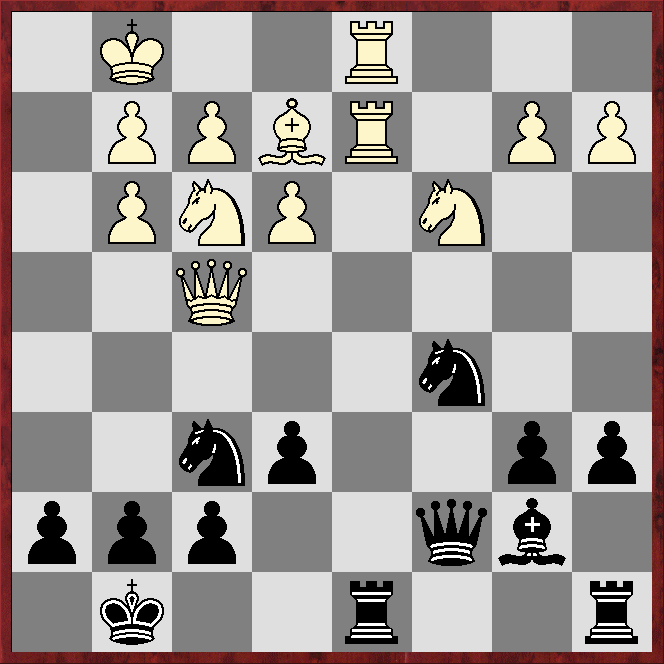London System
1.d4 d5 2.Nf3 e6 3.Bf4 Bd6 4.Bg3 b6 5.e3 Bb7
Black can more-or-less force an exchange of the bad black bishop for the good white bishop (based on the central pawn-formation) with 5...Ba6, but 6.Bxa6 Nxa6 7.Qe2 gives White a handy lead in development.
6.Be2 Nd7 7.0-0 Qe7 8.c4 Ngf6 9.Nc3 0-0
*****
*****
*****
*****
Visually, to me at least, the position looks fairly even, except White has two pawns on the fourth rank against Black's one. The white queen's knight is more-actively placed than its black counterpart, but the black light-square bishop is more-active than the white light-square bishop. Stockfish15 and Komodo13.02 reckon White has a slight edge.
10.Qb3 dxc4!? 11.Qxc4 Bxg3 12.hxg3 c5 13.Rfd1 Rfc8!?
I was reluctant to unprotect the a7 pawn, but 13...Rac8 may be better.
14.Rd2 a6 15.dxc5 Nxc5 16.Qb4 Qc7 17.Rad1 Rcd8 18.Qf4!?
*****
*****
*****
*****
18...Qe7
An only-move, as 18...Qxf4?? loses to 19.Rxd8+ etc.
19.Rd6 Nd5?!
Almost certainly better is 19...Rxd6, and if 20.Rxd6 then 20...b5.
20.Nxd5 Bxd5 21.Rxb6 Bxa2?!
Restoring material equality, but the engines reckon better is 21...a5.
22.Rxd8+ Qxd8 23.Rd6
Komodo13.02 prefers 23.Rc6, but Stockfish15 flicks between the two moves.
23...Qc8 24.Nd4?!
The knight looks well-placed on d4, but it is not threatening anything in particular. Probably better is 24.b4, threatening the queen's knight, or 24.Ne5, threatening to capture on f7, in either case with something of an initiative.
24...Bd5 25.Bf3?!
Now Black gets an initiative.
25...Nd3 26.Qh4 Bxf3?
Better is 26...Qc1+, probably meeting 27.Kh2 with 27...h6!?, although 28.Nxe6!? fxe6 29.Bxd5 exd5 30.Qh5 Qc4 31.f3 is hard to assess, but is equal, according to the engines. Also interesting is 29.Rxd5!? Nxf2!? 30.Rd8+ Rxd8 31.Qxd8+ Kh7 32.g4 (avoiding 32...Qh1#) Qxe3 33.Qd6, which the engines again reckon is equal.
27.gxf3?
White is better after 27.Nxf3, not least because 27...Qc1+?? 28.Kh2 leaves Black unable to stop back-rank mate at the same time as protecting the black knight.
27...Qc1+ 28.Kg2
Perversely, protecting the f2 pawn in the short run means it cannot be saved in the medium term. Correct is 28.Kh2!, which does save the f2 pawn thanks to the threat of back-rank mate. If Black replies, as in the game, 28...h6?? then 29.Qe4, forking knight and rook, wins. Instead Black should play 28...Rf8 or 28...Qc5 with approximate equality.
28...h6
*****
*****
*****
*****
29.Rd8+?
The engines give 29.Qe4 Ne1+ 30.Kh2!? Rf8!?, awarding Black the upper hand.
29...Rxd8 30.Qxd8+ Kh7 31.Nxe6
Everything else is even worse, but this combination, initiated at move 29, does not work.
31...Ne1+ 32.Kh3
Best is the paradoxical 32.Kf1!, eg 32...fxe6?! 33.Ke2 Ng2 (33.Nc2 Qd3+ etc draws) 34.Qd3+ Kg8 35.Qd8+ Kf7 36.Qd7+ Kf6 37.Qd4+ Kg6 38.Qe4+ Kf7 39.Qb7+ Kf6 40.Qb4 with drawing chances. However 32...Nxf3+ 33.Kg2 Ne1+ 34.Kf1 fxe6 35.Ke2 Qxb2+ is good for Black, according to the engines, but difficult to win over-the-board because of the exposed black king.
32...fxe6 33.Qa8 Qc5 34.Qe4+?
The engines reckon White is roughly the equivalent of a queen down anyway, but allowing queens to come off leaves White helpless.
34...Qf5+ (0-1, 41 moves).



No comments:
Post a Comment